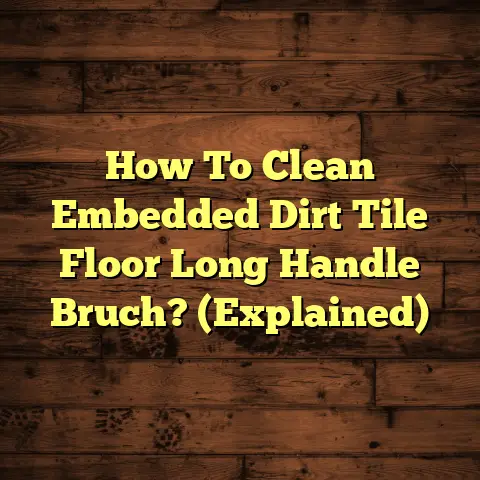Do Dogs Ruin Wood Floors? (Quick Damage Check!)
I get it. You adore your furry friend, but you also cherish your beautiful hardwood floors.
The question that probably keeps you up at night is: “Can I really have both?”
What happens when playful paws meet polished wood? It’s a common worry, and honestly, a valid one.
I’m a flooring contractor, and I’ve seen it all – the good, the bad, and the downright disastrous when it comes to dogs and wood floors.
Let’s dive into the nitty-gritty of dog-related floor damage and how to spot it early.
1. Understanding the Types of Damage Dogs Can Cause
Okay, so what are we up against? Dogs, bless their hearts, can be tough on wood floors.
Here’s a breakdown of the most common types of damage I see:
Scratches and Scuffs
Those adorable little claws? They’re like tiny ice skates on your wood.
Even trimmed nails can leave fine scratches, and untrimmed ones? Forget about it!
Think deep gouges.
Breed matters here, too. A tiny Chihuahua isn’t going to do as much damage as a Great Dane, simply due to size and weight.
Nail length and sharpness are key factors. I’ve seen everything from hairline scratches to deep grooves that require sanding and refinishing.
Stains from Urine or Other Accidents
Accidents happen. We know this. But dog urine is no joke for wood floors.
It’s acidic and can penetrate the finish, leading to discoloration and even permanent stains.
The longer it sits, the worse it gets. Ammonia in the urine reacts with the wood, causing dark spots that are a pain to remove.
Other “accidents” like vomit or diarrhea can also cause staining if not cleaned up immediately.
Dents from Dropping Objects or Heavy Weight
Think about it: your dog is running through the house, excited to see you.
Maybe they skid and bump into something, or maybe they just are something heavy.
Larger breeds, especially when they jump or run, can create dents in softer wood floors.
Dropping toys, bones, or even themselves with enough force can also leave a mark.
Wear and Tear
This is the slow burn. Day-to-day dog activity adds up over time.
Think of high-traffic areas like hallways or the spot where your dog always greets you at the door.
Constant walking, running, and turning can wear down the finish, leaving the wood exposed and vulnerable.
Over time, this leads to a dull, worn-out appearance.
2. Factors That Influence Damage
Not all dogs and floors are created equal. Several factors influence how much damage your dog might inflict on your wood floors.
Breed Size and Activity Level
This is a big one. A 150-pound Saint Bernard is going to have a different impact than a 10-pound Yorkie.
Larger, more active breeds put more stress on the floor. They have more weight, longer strides, and more energy to exert while running and playing indoors.
Smaller, less active breeds are generally gentler on floors, but they can still cause scratches and stains.
Nail Care
Regular nail trimming is essential. Seriously, this is the easiest way to minimize scratches.
Long nails act like tiny chisels, digging into the wood with every step. Keep those nails trimmed short, and you’ll see a noticeable difference.
I recommend trimming them every 2-3 weeks, or more often if needed.
Flooring Type and Finish
Not all wood floors are created equal. Some are more durable and resistant to damage than others.
-
Hardness: Softer woods like pine are more susceptible to dents and scratches than harder woods like oak or maple. The Janka hardness scale measures the resistance of wood to denting and wear. Oak typically scores around 1290, while pine can be as low as 380.
-
Finish: The type of finish also matters. Polyurethane finishes are generally more durable and water-resistant than oil-based finishes. However, oil-based finishes can be easier to repair in the long run.
Age of the Flooring
Older wood floors are often more vulnerable to damage than newer installations.
The finish may be worn down, and the wood itself may be more brittle.
Plus, older floors may have gaps or cracks that can trap dirt and moisture, making them more susceptible to stains and warping.
3. Quick Damage Check Guide
Alright, time to play detective! Let’s get down to brass tacks and learn how to assess the damage your dog may (or may not!) be causing.
Visual Inspection
Grab a flashlight and get down on your hands and knees. Seriously, you need to get close to the floor to see the details.
-
Scratches: Look for fine lines or deeper grooves running along the surface of the wood. Pay attention to high-traffic areas and spots where your dog likes to play or sleep.
-
Stains: Check for discoloration, especially around baseboards, doorways, and areas where your dog might have accidents. Look for dark spots, rings, or a general dullness in the finish.
-
Dents: Shine the flashlight at an angle to highlight any indentations or depressions in the wood. Dents can be subtle, so take your time and look closely.
Touch and Feel Test
Run your hand over the floor, paying attention to any rough patches or unevenness.
-
Roughness: This could indicate scratches, worn-down finish, or areas where the wood has been damaged.
-
Unevenness: This could be a sign of dents, warping, or cupping (where the edges of the boards are higher than the center).
Smell Test for Stains
This one might sound weird, but it works! If you suspect urine stains, get down on your hands and knees and take a sniff.
Urine has a distinctive odor, even after it’s been cleaned. If you detect a lingering ammonia smell, there’s a good chance you have a stain that needs attention.
4. Case Studies or Anecdotes
Let me share a couple of stories from my experience:
-
The Great Dane Disaster: I had a client with beautiful, newly installed maple floors and a very enthusiastic Great Dane. Despite regular nail trims, the dog’s size and energy level quickly took a toll. Within a year, the floors were covered in scratches and dents. They ended up opting for a more durable flooring option in high-traffic areas.
-
The Yorkie Surprise: On the other hand, I had another client with older oak floors and a tiny Yorkie. They were convinced their dog wasn’t causing any damage, but a closer inspection revealed several urine stains around the baseboards. Turns out, even small dogs can have accidents that go unnoticed.
These stories highlight the importance of being vigilant and proactive when it comes to protecting your wood floors.
5. Expert Opinions
I consulted with Dr. Emily Carter, a veterinarian, and she emphasized the importance of regular nail maintenance for dogs living in homes with hardwood floors.
“Think of it like this,” she said. “Your dog’s nails are constantly growing, and if they’re not trimmed regularly, they can become sharp and cause damage to your floors, furniture, and even your skin.”
She also recommended using paw wax to provide additional traction and prevent slipping, which can reduce the risk of scratches and dents.
From a flooring perspective, my colleague, Mark Johnson, a flooring specialist, suggests choosing the right type of wood and finish for pet owners.
“Harder woods like oak, maple, or hickory are generally more resistant to scratches and dents than softer woods like pine or fir,” he explained. “And polyurethane finishes offer better protection against moisture and stains than oil-based finishes.”
He also recommended considering engineered hardwood, which has a more stable core that is less prone to warping and cupping than solid hardwood.
6. Conclusion
So, do dogs ruin wood floors? The answer is… it depends.
Dogs can impact your flooring, but understanding the nature of the damage and being vigilant can help you manage the situation effectively.
Regular nail trims, prompt clean-up of accidents, and choosing the right type of flooring and finish can all make a big difference.
Ultimately, it’s about finding a balance between providing a loving home for your dog and protecting your investment in your wood floors.
It’s a challenge, no doubt, but one that many of us face and can navigate successfully.
Here’s to happy dogs and (relatively) pristine floors!





